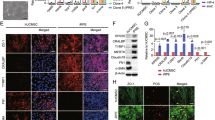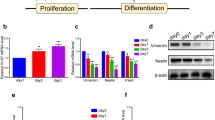Abstract
The retinal pigment epithelium (RPE) is a highly specialized cell type located between the choroid and neural retina of the eye. RPE degeneration causes irreversible visual impairment, extending to blindness. Cell therapy has recently emerged as a potential therapeutic approach for retinal degeneration. MicroRNA-based differentiation of stem cells is a new strategy for producing tissue-specific cell types. In this study, we developed a novel microRNA-based strategy for RPE induction from human amniotic epithelial stem cells (AESCs). We identified microRNAs involved in RPE development in AESCs. Of 29 putative human RPE-relevant microRNAs, microRNA-410 (miR-410) was predicted to target multiple RPE development-relevant genes. Inhibition of miR-410 induces overexpression of immature and mature RPE-specific factors, including OTX2, RPE65, Bestrophin and EMMPRIN. These RPE-like cells were morphologically altered toward a cobblestone-like shape and were able to phagocytize microbeads. We showed that miR-410 directly regulates predicted target genes OTX2 and RPE65. Our microRNA-based strategy demonstrated RPE differentiation in AESCs by treatment of an antisense microRNA-410 (anti-miR-410), without the use of additional factors or exogenous transduction. These findings suggest that miR-410 inhibition can be a useful tool for directed cell differentiation and an attractive method for cell therapy in human retinal degenerative diseases.





Similar content being viewed by others
References
Resnikoff, S., Pascolini, D., Etya’ale, D., et al. (2004). Global data on visual impairment in the year 2002. Bulletin of the World Health Organization, 82, 844–51.
Strauss, O. (2005). The retinal pigment epithelium in visual function. Physiological Reviews, 85, 845–81.
Pascolini, D., & Mariotti, S. P. (2012). Global estimates of visual impairment: 2010. The British Journal of Ophthalmology, 96, 614–8.
Lavinsky, D., Chalberg, T. W., Mandel, Y., et al. (2013). Modulation of transgene expression in retinal gene therapy by selective laser treatment. Investigative Ophthalmology and Visual Science, 54, 1873–80.
Aoki, H., Hara, A., Nakagawa, S., et al. (2006). Embryonic stem cells that differentiate into RPE cell precursors in vitro develop into RPE cell monolayers in vivo. Experimental Eye Research, 82, 265–74.
Sonoda, S., Spee, C., Barron, E., Ryan, S. J., Kannan, R., & Hinton, D. R. (2009). A protocol for the culture and differentiation of highly polarized human retinal pigment epithelial cells. Nature Protocols, 4, 662–73.
Osakada, F., Ikeda, H., Sasai, Y., & Takahashi, M. (2009). Stepwise differentiation of pluripotent stem cells into retinal cells. Nature Protocols, 4, 811–24.
Buchholz, D. E., Hikita, S. T., Rowland, T. J., et al. (2009). Derivation of functional retinal pigmented epithelium from induced pluripotent stem cells. Stem Cells, 27, 2427–34.
Wolber, W., Ahmad, R., Choi, S. W., et al. (2013). Phenotype and Stability of Neural Differentiation of Androgenetic Murine ES Cell-Derived Neural Progenitor Cells. Cell Medicine, 5, 29–42.
Banas, R. A., Trumpower, C., Bentlejewski, C., Marshall, V., Sing, G., & Zeevi, A. (2008). Immunogenicity and immunomodulatory effects of amnion-derived multipotent progenitor cells. Human Immunology, 69, 321–8.
Muttini, A., Valbonetti, L., Abate, M., et al. (2013). Ovine amniotic epithelial cells: in vitro characterization and transplantation into equine superficial digital flexor tendon spontaneous defects. Research in Veterinary Science, 94, 158–69.
Barboni, B., Russo, V., Curini, V., et al. (2012). Achilles tendon regeneration can be improved by amniotic epithelial cell allotransplantation. Cell Transplantation, 21, 2377–95.
Cargnoni, A., Gibelli, L., Tosini, A., et al. (2009). Transplantation of allogeneic and xenogeneic placenta-derived cells reduces bleomycin-induced lung fibrosis. Cell Transplantation, 18, 405–22.
Sakuragawa, N., Yoshikawa, H., & Sasaki, M. (1992). Amniotic tissue transplantation: clinical and biochemical evaluations for some lysosomal storage diseases. Brain and Development, 14, 7–11.
Scaggiante, B., Pineschi, A., Sustersich, M., Andolina, M., Agosti, E., & Romeo, D. (1987). Successful therapy of Niemann-Pick disease by implantation of human amniotic membrane. Transplantation, 44, 59–61.
Bailo, M., Soncini, M., Vertua, E., et al. (2004). Engraftment potential of human amnion and chorion cells derived from term placenta. Transplantation, 78, 1439–48.
Miki, T., Lehmann, T., Cai, H., Stolz, D. B., & Strom, S. C. (2005). Stem cell characteristics of amniotic epithelial cells. Stem Cells, 23, 1549–59.
De Coppi, P., Bartsch, G., Jr., Siddiqui, M. M., et al. (2007). Isolation of amniotic stem cell lines with potential for therapy. Nature Biotechnology, 25, 100–6.
Niknejad, H., Peirovi, H., Ahmadiani, A., Ghanavi, J., & Jorjani, M. (2010). Differentiation factors that influence neuronal markers expression in vitro from human amniotic epithelial cells. European Cells and Materials, 19, 22–9.
Huang, C., Zhang, J., Ao, M., et al. (2012). Combination of retinal pigment epithelium cell-conditioned medium and photoreceptor outer segments stimulate mesenchymal stem cell differentiation toward a functional retinal pigment epithelium cell phenotype. Journal of Cellular Biochemistry, 113, 590–8.
Vossmerbaeumer, U., Ohnesorge, S., Kuehl, S., et al. (2009). Retinal pigment epithelial phenotype induced in human adipose tissue-derived mesenchymal stromal cells. Cytotherapy, 11, 177–88.
Li, Y., Atmaca-Sonmez, P., Schanie, C. L., Ildstad, S. T., Kaplan, H. J., & Enzmann, V. (2007). Endogenous bone marrow derived cells express retinal pigment epithelium cell markers and migrate to focal areas of RPE damage. Investigative Ophthalmology and Visual Science, 48, 4321–7.
Pillai, R. S., Bhattacharyya, S. N., & Filipowicz, W. (2007). Repression of protein synthesis by miRNAs: how many mechanisms? Trends in Cell Biology, 17, 118–26.
Valencia-Sanchez, M. A., Liu, J., Hannon, G. J., & Parker, R. (2006). Control of translation and mRNA degradation by miRNAs and siRNAs. Genes & Development, 20, 515–24.
Yoo, A. S., Sun, A. X., Li, L., et al. (2011). MicroRNA-mediated conversion of human fibroblasts to neurons. Nature, 476, 228–31.
Hu, G., Huang, K., Yu, J., et al. (2012). Identification of miRNA signatures during the differentiation of hESCs into retinal pigment epithelial cells. PloS One, 7, e37224.
Sakami, S., Hisatomi, O., Sakakibara, S., Liu, J., Reh, T. A., & Tokunaga, F. (2005). Downregulation of Otx2 in the dedifferentiated RPE cells of regenerating newt retina. Brain Research. Developmental Brain Research, 155, 49–59.
Martinez-Morales, J. R., Dolez, V., Rodrigo, I., et al. (2003). OTX2 activates the molecular network underlying retina pigment epithelium differentiation. The Journal of Biological Chemistry, 278, 21721–31.
Martinez-Morales, J. R., Signore, M., Acampora, D., Simeone, A., & Bovolenta, P. (2001). Otx genes are required for tissue specification in the developing eye. Development, 128, 2019–30.
Moiseyev, G., Chen, Y., Takahashi, Y., Wu, B. X., & Ma, J. X. (2005). RPE65 is the isomerohydrolase in the retinoid visual cycle. Proceedings of the National Academy of Sciences of the United States of America, 102, 12413–8.
Jin, M., Li, S., Moghrabi, W. N., Sun, H., & Travis, G. H. (2005). Rpe65 is the retinoid isomerase in bovine retinal pigment epithelium. Cell, 122, 449–59.
Redmond, T. M., Yu, S., Lee, E., et al. (1998). Rpe65 is necessary for production of 11-cis-vitamin A in the retinal visual cycle. Nature Genetics, 20, 344–51.
Jin, M., Yuan, Q., Li, S., & Travis, G. H. (2007). Role of LRAT on the retinoid isomerase activity and membrane association of Rpe65. The Journal of Biological Chemistry, 282, 20915–24.
Roh DH, Seo MS, Choi HS, et al. Transplantation of human umbilical cord blood or amniotic epithelial stem cells alleviates mechanical allodynia after spinal cord injury in rats. Cell transplantation 2013.
Park, S. B., Yu, K. R., Jung, J. W., et al. (2009). bFGF enhances the IGFs-mediated pluripotent and differentiation potentials in multipotent stem cells. Growth Factors, 27, 425–37.
Dunn, K. C., Aotaki-Keen, A. E., Putkey, F. R., & Hjelmeland, L. M. (1996). ARPE-19, a human retinal pigment epithelial cell line with differentiated properties. Experimental Eye Research, 62, 155–69.
Liao, J. L., Yu, J., Huang, K., et al. (2010). Molecular signature of primary retinal pigment epithelium and stem-cell-derived RPE cells. Human Molecular Genetics, 19, 4229–38.
Mellough, C. B., Sernagor, E., Moreno-Gimeno, I., Steel, D. H., & Lako, M. (2012). Efficient stage-specific differentiation of human pluripotent stem cells toward retinal photoreceptor cells. Stem Cells, 30, 673–86.
Meyer, J. S., Howden, S. E., Wallace, K. A., et al. (2011). Optic vesicle-like structures derived from human pluripotent stem cells facilitate a customized approach to retinal disease treatment. Stem Cells, 29, 1206–18.
Meyer, J. S., Shearer, R. L., Capowski, E. E., et al. (2009). Modeling early retinal development with human embryonic and induced pluripotent stem cells. Proceedings of the National Academy of Sciences of the United States of America, 106, 16698–703.
Idelson, M., Alper, R., Obolensky, A., et al. (2009). Directed differentiation of human embryonic stem cells into functional retinal pigment epithelium cells. Cell Stem Cell, 5, 396–408.
Cui, L., Shi, Y., Zhou, X., et al. (2013). A set of microRNAs mediate direct conversion of human umbilical cord lining-derived mesenchymal stem cells into hepatocytes. Cell death and disease, 4, e918.
Cai, B., Li, J., Wang, J., et al. (2012). microRNA-124 regulates cardiomyocyte differentiation of bone marrow-derived mesenchymal stem cells via targeting STAT3 signaling. Stem Cells, 30, 1746–55.
Miyoshi, N., Ishii, H., Nagano, H., et al. (2011). Reprogramming of mouse and human cells to pluripotency using mature microRNAs. Cell Stem Cell, 8, 633–8.
Li, W. B., Zhang, Y. S., Lu, Z. Y., et al. (2012). Development of retinal pigment epithelium from human parthenogenetic embryonic stem cells and microRNA signature. Investigative Ophthalmology and Visual Science, 53, 5334–43.
Conte, I., Carrella, S., Avellino, R., et al. (2010). miR-204 is required for lens and retinal development via Meis2 targeting. Proceedings of the National Academy of Sciences of the United States of America, 107, 15491.
Walker, J. C., & Harland, R. M. (2009). microRNA-24a is required to repress apoptosis in the developing neural retina. Genes and Development, 23, 1046–51.
Qiu, R., Liu, K., Liu, Y., et al. (2009). The role of miR-124a in early development of the Xenopus eye. Mechanisms of Development, 126, 804–16.
Nguyen, M., & Arnheiter, H. (2000). Signaling and transcriptional regulation in early mammalian eye development: a link between FGF and MITF. Development, 127, 3581–91.
Acknowledgments
This research was supported by the MOTIE (The Ministry of Trade, Industry and Energy), Korea, under the Global collaborative R&D program (No. M0000049) supervised by the KIAT (Korea Institute for Advancement of Technology), and partially supported by the Research Institute for Veterinary Science, Seoul National University (SNU, Republic of Korea).
Conflict of Interest
The authors declare no potential conflicts of interest.
Author information
Authors and Affiliations
Corresponding author
Additional information
Soon Won Choi and Jae-Jun Kim These authors contributed equally to this work.
Rights and permissions
About this article
Cite this article
Choi, S.W., Kim, JJ., Seo, MS. et al. miR-410 Inhibition Induces RPE Differentiation of Amniotic Epithelial Stem Cells via Overexpression of OTX2 and RPE65. Stem Cell Rev and Rep 11, 376–386 (2015). https://doi.org/10.1007/s12015-014-9568-2
Published:
Issue Date:
DOI: https://doi.org/10.1007/s12015-014-9568-2




